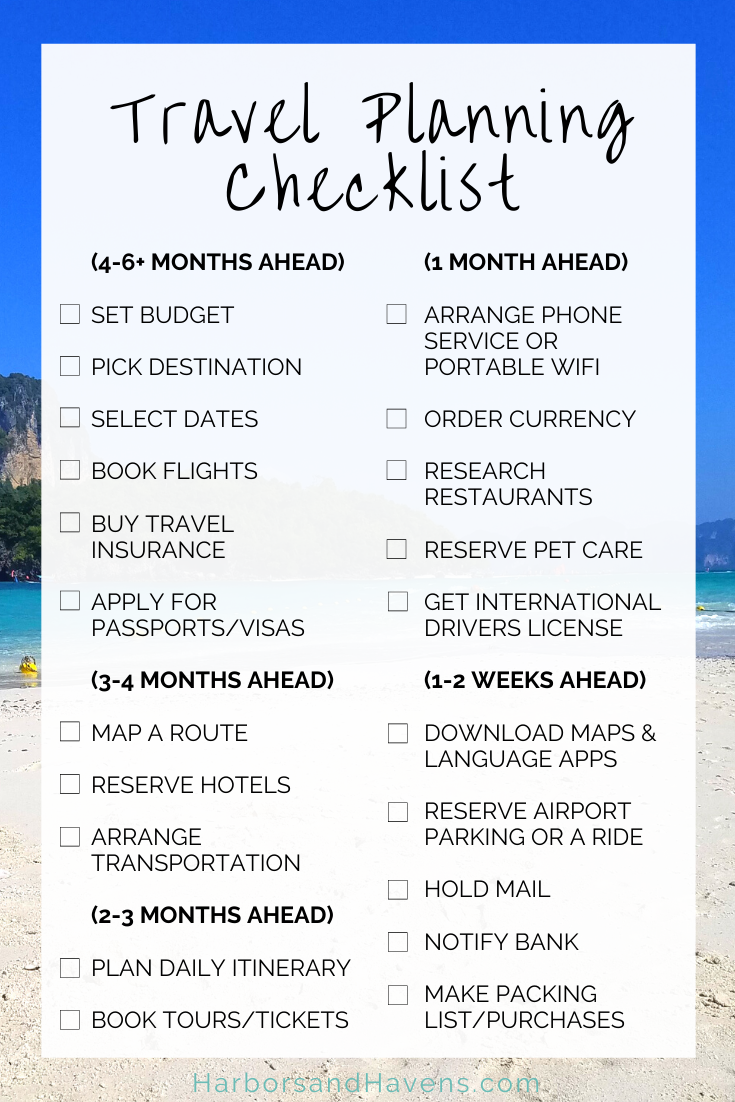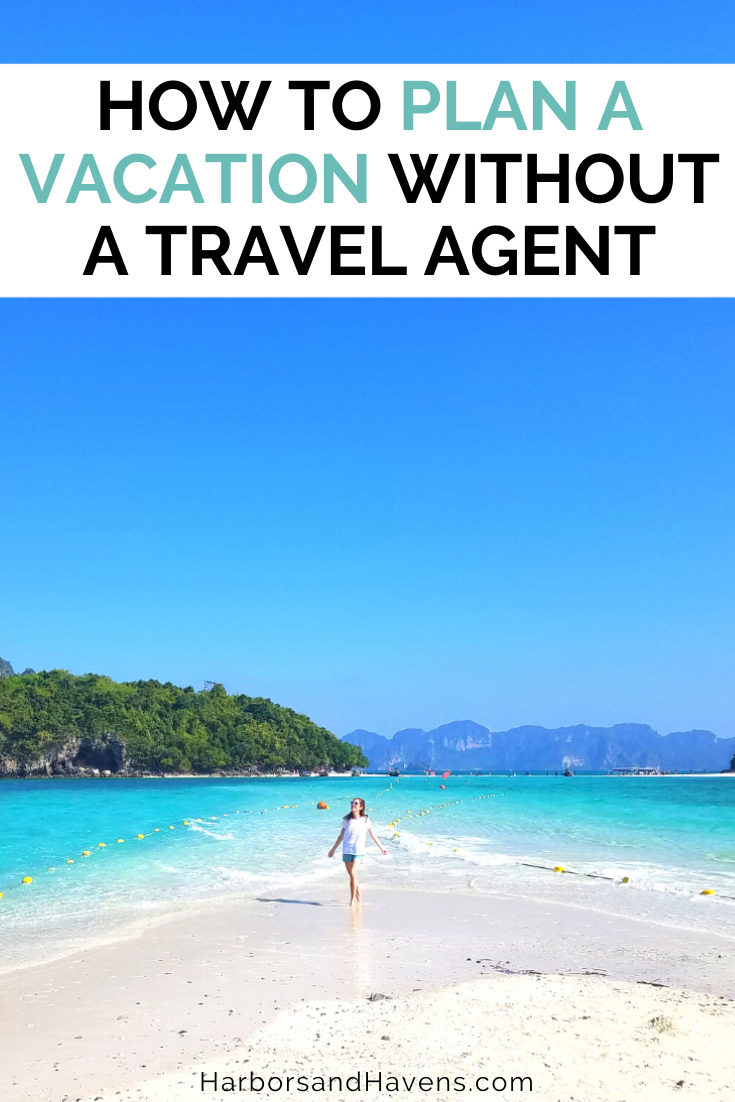This is How to Plan a Trip Abroad for the First Time
Passports, flight schedules, hotels, vacation rentals, trains, tours, itineraries, packing — there’s a lot to remember when booking a vacation. That’s why many hopeful tourists hire travel agents or simply put off going somewhere new and instead return to familiar cruises and beach vacations.
I agree that it’s a bit overwhelming at first, especially when you’re planning a once-in-a-lifetime kind of trip. But, with the wealth of information online these days and a little practice, you can absolutely plan an independent vacation.
What is an independent vacation? It’s one where you arrange things yourself, instead of using a travel company to book your flights, hotels and tours. I narrow that down a little more to also exclude things like cruises or escorted tours, which are mostly all planned for you.
Independent trips can be anything from spending a few days exploring a big city to taking a road trip to country-hopping in Europe. Independent travel by far offers the most flexibility to go where you want, do what you enjoy, and check things off your personal travel bucket list.
I’ve arranged my own travel to about 20 countries now, from solo trips to family ones, so things like flight research and finding the best hotel deals comes naturally at this point.
The detailed guide below will help you start booking your own domestic and international travel and skip some of the trial and error I experienced along the way. It’s full of tips and tricks to save you money and headache, so be sure to read between the headlines. Scroll down for a handy checklist you can save to Pinterest.
Read Next: 10 of the Best Ideas for a Travel Themed Staycation
Set a Budget
One of the very first steps to planning a vacation should be deciding how much you can spend. This should be done collaboratively with anyone else involved in the trip, whether a spouse, other adult family members, or friends.
Deciding how much you can afford will help with the next several steps, as you’ll quickly be able to determine which destinations are on the table, and which need to be put on hold while you save up.
Don’t automatically discount international destinations even if your budget is small. Shopping for flight deals and skipping fancy hotels or lots of shopping will make it much more affordable.
Read Next: 21 Ways to Save Money and Travel More
Pick a Destination
This step is always the hardest for me because the wish list is so long. My final decision often is determined in the flight booking stage depending on where I find the best deals, but it’s handy to have a few places in mind so you can narrow your search.
If you already have a locale picked out, now is a good time to decide on the scope of your trip — will you stay in one city with day trips, hop around to a few destinations, take a road trip? It’s helpful to have an idea formed before booking flights because you might not want to fly in and out of the same airport.
Select Dates
This might be a quick step if you’ve already put in a vacation request or are relying on school holidays. If you’re more flexible, though, consider picking your travel dates in conjunction with booking your flight in order to get the best deals.
Even if your dates are set in stone, check flights for a day before or after to compare prices. Days of the week greatly affect airline fares, and even a $100 difference can add up greatly for a family.
Apply for Passports and Visas
If you decide on an international destination, you’ll need to apply for a passport if you don’t already have one or if yours is set to expire within six months after your trip. In the U.S. you should start this process at least two months before your trip to avoid paying rush fees.
Before booking anything, you’ll also want to check into visa requirements for the countries you plan to visit. In case you’re not familiar, a visa is a special document giving you permission to enter a country for a certain amount of time. U.S. citizens are fortunate to be able to vacation visa-free in approximately 174 countries, including most of Europe.
If you do need one, the process can be as simple as handing over some documents and paying a fee (Cambodia) to as complex as filling out mountains of paperwork and getting a sponsor (Russia). If you’re from the U.S., the state department has a detailed page for each country showing visa and vaccine requirements and travel advisories and alerts.
Book Your Flights
I start all my flight searches on Google Flights, and I highly recommend it. Even if you have loyalty with a particular airline, price shopping will help you know if you’re overpaying, and you might find an alliance or partner airline to your favorite that allows you to book an award seat with your points.
If you already have a destination determined, start by plugging in your departure and arrival airport and then click the calendar box. This will quickly show you the cheapest dates to travel on.
If you’re planning a road trip or city-hopping itinerary that will take you far from your initial destination, you’ll want to research the price of an “open jaw” ticket. An open-jaw is when you don’t fly into and out of the same destination on both ends of the journey. So, instead of city A (origin) to B (first destination) and B back to A, you fly A to B and C (final destination) back to A. Sometimes you’ll find a better deal doing this, other times it’ll be wildly expensive. Compare the price to booking a round trip A to B flight and a one-way flight from city C back to B. In some cases, you might drive or take a train back to city B instead. You can figure this out before booking your flight by selecting the “multi-city” option on the search box.
If you’re researching flights in conjunction with picking dates or a destination, use the “explore destinations” option to find the best deals. Add your home airport, then fill in the date box with loose parameters like “2 weeks” and “October.” This will bring up a map view of prices all over the world. You can zoom in on regions you’re considering and see what deals pop up.
To be a total flight deal nerd, sign up for Scott’s Cheap Flights to get inbox alerts for deals from airports you want to follow. If you skim these enough, you’ll start to notice which airports frequently have good prices on certain routes.
Another pro tip — do all your flight research in a private browser (ctrl-shift-n on Chrome) so that your search cookies aren’t saved. Sometimes prices will suspiciously go up after you’ve searched.
Purchase Travel Insurance
To tell the truth, I didn’t buy travel insurance for the first few times I went abroad. Mostly because I didn’t really know about it and partly to save money. But, I’ve realized over the years that the peace of mind is absolutely worth the few dollars, especially when it comes to potential medical emergencies overseas that could cost a fortune if you need a hospital stay or evacuation.
There are tons of different policies out there, but I prioritize plans with lots of coverage for medical emergencies, with things like flight and hotel cancelation as a secondary need. Basically, I figure losing money on flights would be very unfortunate and frustrating, but not having proper medical coverage could be financially ruining.
You’ll want to buy travel insurance within two weeks of your initial trip purchase or deposit because a lot of policies offer the best coverage in that window. That often means estimating the cost of the rest of your trip before you’ve booked things like hotels.
And just to be clear, the travel insurance I purchase is not the little flight insurance policies that airlines try to upsell when you book. I always skip those and shop for my own policy.
Research and Map Out a Route
Once you’ve picked your main destination and booked a round-trip or open-jaw flight, it’s time to narrow down a route. If you’re planning to make a hub in one city, you can skip this step, as you’ll arrange day trips further along.
If you plan to road trip or city hop using trains and buses, go ahead and plot out a path and determine how many days to spend in each locale. Consult some blogs for itineraries in different cities to help with this. You can use Google Maps to track distances between destinations by car, train, bus and so on and even print or share a map link with your travel crew.
Reserve Accommodations
I’ve booked hotels as close as a week out from my stay, but I recommend securing them at least a couple of months ahead to get the best deals and most availability.
If you’re new to booking your own accommodation, you should know that there are so many options out there — resorts, hotel chains, locally owned inns, bed-and-breakfasts, vacation rentals, hostels, farm stays, glamping, camping. What you pick is really up to your budget, taste and how many people you have with you. House rentals sometimes work out best for families and large groups, while hostels will typically be the cheapest option for solo travelers.
I like to use an aggregate hotel searcher like Booking or Google Hotels to make sure I’m seeing lots of options. Sites like Airbnb and VRBO are great for vacation rentals. You can narrow down choices based on your prices and specific needs, and then use a map tool and start with the locations closest to where you want to be based.
Read Next: These Santorini Greece Hotels and Villas Have the Best Views on the Island
Arrange Transportation
After you’ve nailed down flights, hotels and a route, you can start working on the smaller details, like transportation. This could be booking a rental car, reserving an airport pick up or buying train or bus tickets.
Reservations like a car hire should be done at least a couple of months in advance if possible, while things like train and bus tickets can sometimes be purchased after you’ve arrived. If you are planning to drive abroad, lookup whether you will need an international driving permit and get one from AAA (even if you aren’t a member).
It’s a good idea at this stage in planning to make a list of the transit options you’ll be using and do a little research into whether you need to pre-book tickets or buy some kind of travel card. Sometimes purchasing tickets in advance will yield the best deals.
If you’re a super planner or just traveling abroad for the first time, you can also do things like print or screenshot subway and bus routes, figure out whether you’ll need a credit card or cash on site, and download the local rideshare apps.
Read Next: Try These Fun Staycation Ideas When You’re Stuck at Home
Plan a Daily Itinerary
Some folks like to do things on the fly and others like to plan things down to the minute. No matter where you fall on that scale, it will be helpful to have an idea of what you intend to do in each destination before booking tours, tickets or day trips — the next step.
If you’re winging it, go ahead and move on, the following info is for the planning people.
While schedules can always be disrupted and part of the fun of travel is being in the moment, I find it logical to have a rough itinerary and determine which days to do certain activities. Why? Well, if you don’t, you might find yourself in a situation where the museum you wanted to visit is closed on the day you go, a tour you’d like to do is sold out, everything shuts down earlier than you anticipated, and so on.
During this phase of planning, I make a list of all the attractions I want to go and jot down their opening times, ticket prices, suggested length of visit, and any special deals (like free on Fridays, half off after 6 p.m., discounted with a combo ticket). It’s also helpful in large cities like London or Paris to pull up Google maps and see which places are near each other and make a natural combination.
You can also consult blogs to get an idea of what others were able to fit into a day and places to skip or savor. Just remember that everyone has different tastes and priorities. For example, I never spend much more than a couple of hours in a museum while traveling, but you might want to wander the halls for a whole day. I hate things like wax museums and hop-on buses, you may love them. I don’t do nightlife, you might sleep in every day. It’s your trip and it’s OK to do what you enjoy.
After all that research, itineraries tend to be a lot easier to piece together. You can check out a few of my travel itineraries to get ideas. Some pro tips — plan to hit the most popular sites right when they open, alternate busy and more low-key days, allow transit time between attractions, don’t forget to work in time for meals/naps/etc.
Line Up Tours and Tickets
The timetable for booking tours and tickets varies widely. If you’re taking a guided day trip or trying to secure a specific time slot for an uber-popular attraction, you might need to make reservations months in advance. If you’re just buying tickets to a museum or palace, often you can wait until you arrive.
The travel planning stage of this is just determining which things you need to reserve ahead and which can wait. You can do this simply by visiting the website for the attraction or activity, as long as they have one. If they don’t, see if any blogs or tourism sites have ticket instructions.
Research Restaurants
I always skip this step and often wish I had done more research in advance. If you’re a big foodie, you may want to make a list of some restaurants or dishes you’re dying to try. There are tons of great food and travel blogs out there full of ideas. Just remember that some hole-in-the-wall places may go mostly undetected online. The best people to ask for recommendations are locals.
Finish Final Details
With the bulk of planning done, you can turn your attention to small details and packing lists in the final couple of weeks.
And before you leave, be sure to unplug and turn off unneeded appliances and electronics and lock up the house!
Travel Planners and Journals
These travel planners have space to track your hotel reservations, flight details, packing lists and daily itineraries. Plus, they’re a great way to store memories after your trip.















